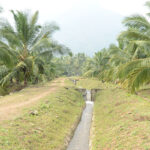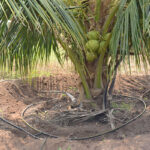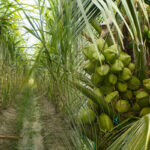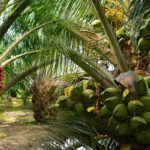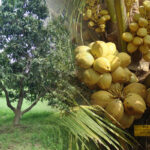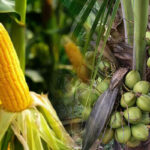What is a Hybrid Coconut Palm?
Coconut Palms are categorized as either Dwarf or Tall Palms. Generally a hybrid is a cross between the two. Hence you can have a D x T where the mother is the Dwarf, or a T X D. D x T are generally considered better. You can also have a D x D or a T x T when different cultivars or pure-lines are crossed into each other, to produce hybrid vigour. The purpose of Hybridization is greater productivity due to hybrid vigour.
What is the Deejay Hybrid Coconut Palm?
The Deejay Hybrid Coconut Palm named the Sampoorna Hybrid is a D x T and is produced by hand emasculation and hand pollination of the Deejay Dwarf Palm crossed with the pollen of a special Tall Palm. The new flower spathe is opened in advance, and every male flower removed, leaving only the female embryonic buttons. There are thousands of male flowers and normally less than 100 buttons. At the right time, pollen is spread on the buttons by hand or blown onto them by a bottle puffer.
What is special about the Deejay Sampoorna?
It is a general purpose hybrid, with a larger number of nuts, of largest size with approx. a 200 grams of copra. It flowers and fruits much earlier than the traditional Tall palms. It is the result of over 40 years of research.
Compare the Sampoorna and Local varieties
| PARTICULARS | DEEJAY SAMPOORNA® | REGULAR TALL PALM |
| Flowering begins in | 36 months | 72 months |
| Annual Nuts yield per palm | 250 | 120 |
| Copra content per nut | 210 g | 140 g |
| Oil content in Copra | 68% | 63% |
| Tender Coconut Water approx.. | 500 ml | 200 ml |
| No. of Coconuts per acre | 17,500 | 7,800 |
| Copra per acre | 3,675 kg | 784 kg |
| Coconut oil per acre | 2,500 kg | 494 kg |
Do you guarantee these results?
No, we do not. We cannot guarantee any results when working with nature, nor can anyone do so. However it is our intention to give the best guidance to our customers especially during the first three years of the Sampoorna’s life. The best care given to them at this stage assures the best results in the long run. Genetics contributes only 20% to the performance of the palm. The environment created by nature and the farmer, contributes 80%. Hence the App Deejay4U was created to make great production.
Is it really worthy planting the Sampoorna hybrid considering the higher price, inputs & maintenance costs (Capex & Opex)?
Yes, it is for the person who thinks professionally and wants to make high profits from agriculture. Yes, it is for the farmer who wishes to get three to four time better results and profits compared to routine coconut farming. Do remember inputs for the hybrid are a different not difficult.
What is the Annual Income from One Acre of Sampoorna?
The different environments, management practices and soil and water conditions result in different levels of performance. Some farmers achieve excellent profit exceeding Rs. 4 lakhs per acre, unfortunately most do not. Yet with the correct inputs it is achievable by almost every farmer.
Is the income from Coconut farming stable & better than most other long duration crops?
Yes. The added benefit is that once planted, the coconut estate has little re planting cost for the next 50 years. The growth in demand for the coconut and its products is increasing every year and restricted only by the supply. The greater worldwide awareness of the goodness of the palm and the good health of its products is growing exponentially. Virgin Coconut Oil [VCO] is recognized by more and more people as being the healthiest oil supporting wellness levels and longevity.
What is the easiest way to get the best production?
Do remember that the coconut palm is possibly the most unique plant in the world. All plants and trees have specific seasons for leaf, flower, and fruit production. The coconut palm DOES NOT have different seasons. All processes happen simultaneously in this palm and ONLY in this palm, giving you growth in leaves, flowers and fruit every day of the year. Having evolved on the tropical beaches of the year, being fed by the daily tides, this palm gets its regular daily dose of nutrition. It has therefore evolved to grow and produce daily. Coconut palms growing on the beach are noted for their higher production compared to growing inland. Daily or at least weekly fertigation is closest to this phenomenon. Remember that fertilizing the palm, three or four times a year is a far cry from daily or weekly feeding. There is no alternative to fertigation if best results are targeted. It also simplifies the management, saves labour costs, and is more efficient.
What is the ideal planting season?
Do plant all around the year, with shade to be given in the summer, and excessive irrigation to be reduced in the monsoons. Some farmers think it is better to plant during the rains. Not always. Water logging and bud rot are likely in heavy rainfall areas. One can and should plant coconut seedlings throughout the year, subject to adequate water and shade in the summer. Many farmers prefer planting in the summer, when the seedlings’ water requirements are less, thereby gaining time. The seedlings recover from the transplantation stress, get set, and grow rapidly in the rainy season.
Is the Deejay tender coconut water [TCW] sweet? And what will be the minimum quantity per nut?
Yes, as it has a sugar content around 6 BRIX compared to the traditional Tall with a BRIX level at 3 plus. One should average 500 ml of TCW in a Sampoorna nut harvested at 7 months of age, almost twice that of the regular Tall.
What will be the height of the adult Sampoorna?
Being a cross between the dwarf and the tall palm, its height is in the middle. It grows faster than a dwarf but slower than a tall. The height of the Sampoorna of 20 years in age may be 30 ft compared to 20 ft and 40 ft in the dwarf and the tall respectively.
Why is the price of the Sampoorna more than other hybrids?
The cost of production is the main reason. Here are some of the reasons – Hand emasculation of every flower spathe removing about 10,000 male flowers, hand pollinating every button [embryonic nut about 7 million pollinated in 2023], destroying approx. 20% of the seedlings which are illegitimate [the wind, butterflies and bees bring the wrong pollen to many buttons], absorbing a 20% cost increase due to the Continuous Improvement Program [CIP] wherein we remove a small percentage of poorest performing dwarf mother palm, replacing them with new best pedigreed seedlings, resulting in the breeding estate always having 20% less producing palms, which increase costs and reduce income, etc.
What are the causes for Button Drop?
Shortage of water and humidity, excessive heat, shortage or imbalanced nutrition, depletion of specific micro nutrients (one being Boron); very high or very low pH and EC which block nutrient absorption etc. Today global warming and excessive heat are also considered causes.
Are Deejay Hybrids more sensitive to whitefly and beetles or are they more resistant to pests & disease?
Deejay plants are neither sensitive nor resistant to whitefly & diseases. In general all hybrids have hybrid vigour, which gives them an advantage.
Can we grow Deejay Sampoorna Hybrids organically?
Yes. But we can expect less yield compared to them being grown inorganically. This is the same for all agriculture. Organically grown coconuts with weekly fertigation is the best alternative with little or no loss in yield.
Do we need to apply more fertilizer for the Sampoorna?
As the Sampoorna produces three and more times the bio mass compared to the traditional Tall, it needs better and more nutrition. The increase in nutrition is marginal and beneficial compared to the output and profit which is substantial.
Sometimes we see poor yields in the hybrids compared to local and traditional varieties. Why is this?
Just as a native cow or dog or plant can manage with minimum care and nutrition, the traditional palm also manages. Survival comes first and then productivity. In the hybrid productivity come first compromising survival. Hence the percentage drop in production under adverse conditions is much more in the hybrid compared to the traditional palm.
What are the Intercrops we can grow?
All field crops & vegetables can be grown without any limitation.
While going for fruits &/ perennial intercropping, make sure there is no competition for light, nutrients & water. Spices in particular, do very well, as they require less light.
Can we plant Deejay in Black soil and what will the yield levels be?
Yes, with good results. Prevent water logging by trenching. Yields will not be less if there is no water logging.
What is the pH required and should we avoid soils if the pH is not suitable?
5.5 – 7.0 pH is ideal for Coconut.
If the pH is high (>7) – apply Gypsum. If pH is low (<5) – apply dolomite/lime. Yes, it is advisable to choose other lands if the one chosen has constant pH levels outside the range. However if one has the capacity of constantly monitoring and regulating the pH, then do go ahead even on such “unsuitable” lands.
How important is pH and EC?
Very, very important. The wrong pH, either too high or too low, will directly affect the absorption of nutrients. The wrong pH does exactly that, which means it causes malnutrition. Similarly the EC or electro-conductivity of the water.
Will Deejay take up management of farmers’ coconut estates?
In the first place Deejay is most happy to guide and assist farmers during the first three years of the plants life. The better the start, the better the productivity for the rest of the life of the palm. Thereafter request for visits and consultancy will be charged.
Will Deejay give a buy-back agreement?
At this stage, Deejay is not in a position to do so.




